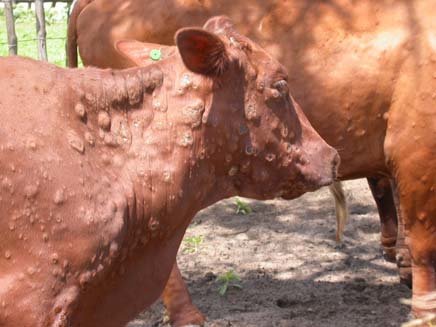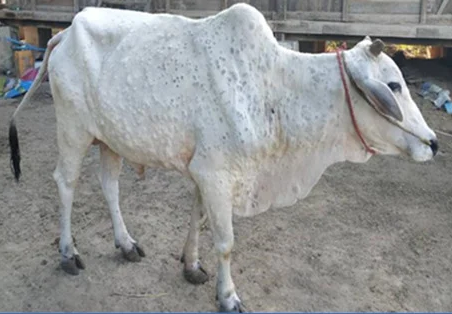
Lumpy skin disease was initially found in southern and eastern Africa, but it is now spreading rapidly throughout the Middle East, Asia, and eastern Europe. India is also affected by this disease; as we all know, the cow is a sacred animal in our culture. It symbolizes Mother Earth since it is a source of kindness and its milk nourishes all living things. Because illness is swiftly spreading from one cattle to another, it is our entire obligation to rescue these animals. Hence we, Ujjawal Jeevan Trust, are doing everything we can to save these cattle that are in terrible pain. It is caused by a lumpy skin disease virus (LSDV), a member of the capripoxvirus genus. This virus belongs to the poxviridae family. Smallpox and monkeypox viruses are both members of the same family. The LSDV has antigenic similarities with the sheep pox virus (SPPV) and the goat pox virus (GTPV), as well as a comparable immunological response. LSD has an impact on ill animals' lymph nodes, causing them to grow and look like lumps on the skin. The nodules may develop into ulcers, causing scabs to appear on the skin.

• The duration between infection and symptoms is roughly 28 days.
• Fever, despondency, skin nodules, decrease in milk supply, and miscarriage in pregnant animals are the early signs of this infection.
• Watery eyes and nasal and salivary secretions get increased.
• Loss of appetite and apprehension to move.
• Skin nodules with a diameter of 5-50 mm and a spherical form begin to rise above the skin, according to clinical indicators diagnosis and our expertise.
• These lumps often emerge 2 days after the onset of fever on the skin of the head, neck, udder, genitalia, perineum, and limbs.
• Nodules can cover the entire body or occur in clusters. The nodules may vanish or ulcerate, leaving scars.
• The nodule's center dies, and the resulting scabs may fall out, leaving huge holes in the skin that might get infected.
• Laboratory examination of blood samples and tissue samples from skin lesions confirms the clinical diagnosis.

The virus is mostly spread mechanically by insect vectors (mosquitoes, flies, ticks, etc.) or infected needles.
• Some of them might be carried away by the wind or the specific vectors that will differ between countries and have received little attention.
• Once established in a new region, the spread is most likely to occur during seasons when flies are a nuisance, such as a summer and autumn months when conditions are damp and warm.
• Contaminated feed, water, and equipment are also a reason for potentially transmitting the illness
• The virus can potentially develop and spread in various environmental and industrial settings worldwide.
• LSD management measures include evacuating clinically afflicted animals, immunizing them, and restricting cattle movement in contaminated regions.
• It is advised to dispose of deceased animals properly (by burning them), as well as to clean and disinfect the area and any equipment.
• By decreasing the movement of cattle.
• LSD management measures include evacuating clinically afflicted animals, immunizing them, and restricting cattle movement in contaminated regions.
• According to health ministry authorities, India is now employing the 'goat-pox' vaccine against the virus, which is proven to be entirely successful. However, supplying vaccination to all cattle is a complex undertaking. Therefore, we treat minimally infected animals with regular medications.
• There is presently no specific medicine or immunization available for this illness; thus, prevention is the best option. As a result, we provide medications based on symptoms.
• Methylene Blue antiviral medication.
• Nonsteroidal anti-inflammatory drugs are used to treat an inflammatory condition.
• Paracetamol is used to treat excessive fever.
• Antibiotics are given to combat secondary infection.
Is lumpy skin condition treatable, and if so, how long does it take? Lumpy Skin Disease does not have therapy. Prevention is the best option. Once an area has been contaminated, it is difficult to keep animals from being attacked. The disease's morbidity ranges from 2% to 45%, and the fatality rate is less than 10%; however, the reported mortality rate of the current epidemic in India is up to 15%. Complete recovery may take several months and may be delayed if additional bacterial infections arise. The treatment aims to prevent or control subsequent infection. It may take up to six months for animals seriously infected by the LSD virus to fully recover.
• Despite this relatively new condition, we have begun several awareness campaigns through posters, banners, and gatherings.
• We attempted to keep grazing areas free of flies and mosquitoes.
• We will never longer share animals, tools, trucks, or employees with other farms.
• We assist folks in obtaining goat pox vaccination for their livestock.
• We divided the kettles into small groups and separated the infected from the uninfected ones.
• We provide helpline numbers for disease-related queries.
• We have set up camps to gather animal blood samples so they may be diagnosed quickly.
What you must do daily to protect your cattle against this virus
Your herd might be in danger. All animals must be checked regularly. Any indication of Lumpy Skin Disease should be immediately reported to a veterinarian and Veterinary Services.

